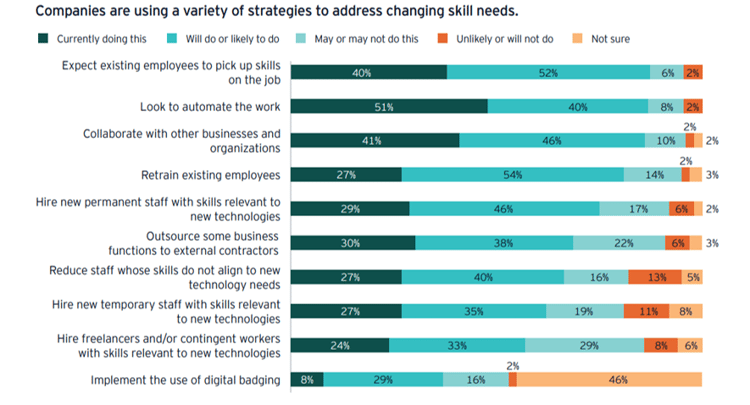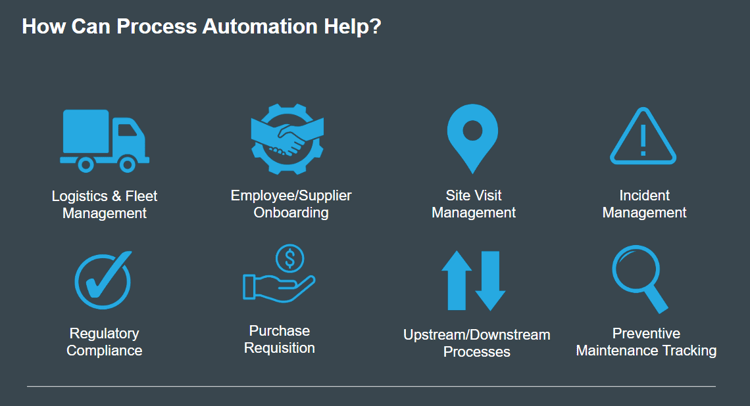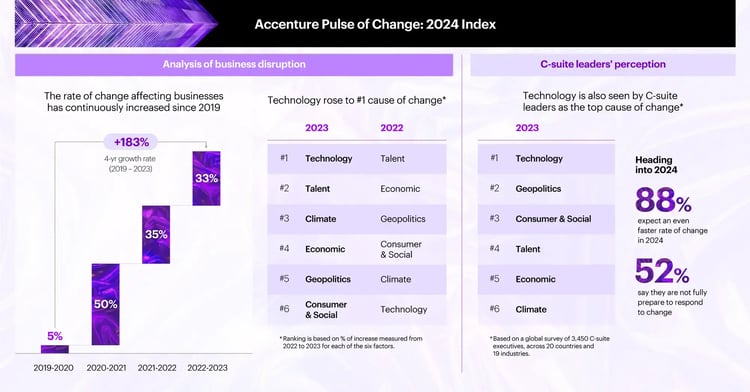This underscores the ongoing adoption of technologies in organizations to transform how employees work, enhancing conditions so they can concentrate on value-added tasks.

My Thoughts On Oil and Gas Digital Transformation
I recently hosted a webinar which focused on oil and gas digital transformation during the Oil & Gas Automation and Digitalization Conference and Exhibition.
In the webinar, I spoke about how digital transformation drives cost savings, productivity improvement and managing risk in the oil and gas industry.
I also provided actionable tips on how to drive a successful digitalization project and choose digital technologies that support your business goals. If you're serious about accelerating digital transformation in oil and gas in 2025, I'd recommend watching my presentation. I hope you enjoy it!
Examples of Digital Transformation in Oil and Gas
1. Digital process automation
Digital process automation focuses on automating manual tasks in the oil and gas industry. At FlowForma, we see digital process automation as the foundation for digital transformation.
By, automating people-centric tasks, organizations will establish a base layer of organizational data to inform additional technology strategies such as artificial intelligence (AI), the Internet of Things and augmented reality (AR).
As shown in the image above, process automation should sit at the heart of your strategy, collecting operational data across all functions, showcasing this data to managers and business leaders and providing a real-time view of activities across the business for informed decision-making.

Key digital process automation use cases in the oil and gas industry:
-
Logistics and fleet management
-
Employee/Supplier onboarding
-
Site visit management
-
Incident management
-
Regulatory compliance
-
Purchase requisition
-
Upstream/downstream processes
-
Preventative maintenance tracking
Take a deeper dive into digital process automation by watching this video:
2. Internet of Things (IoT)
IoT devices are one of the many new digital technologies to emerge in the digital age. In the oil and gas sector, IoT devices provide visibility for equipment and facilities. The devices monitor facilities and identify equipment failures. This information is then provided to maintenance workers onsite to address the technical issues. IoT devices play an increasingly important role in reducing downtime and ensuring revenue continues in the oil and gas sector.
Another key area that IoT devices support is health and safety in oil and gas. IoT devices work 24/7 and in real-time to monitor the environmental workspace. Workers in the oil and gas industry risk exposure to hazards such as gas leaks. IoT devices monitor these potential risks and provide warnings to managers when safety issues are detected.
3. Artificial intelligence (AI)
 According to EY, 50% of oil and gas executives say they have already begun using AI to help solve challenges at their organizations. But how are executives using AI in the oil and gas industry?
According to EY, 50% of oil and gas executives say they have already begun using AI to help solve challenges at their organizations. But how are executives using AI in the oil and gas industry?
The possibilities for AI are endless but some of the key use cases I see regularly include:
Predictive maintenance
AI supports collects, evaluates and produces data models to predict when equipment will deteriorate. Oil and gas organizations use this information to schedule equipment maintenance and prevent downtime.
Monitoring carbon emissions
Organizations can now monitor, analyze and forecast carbon emissions with the power of AI smart monitoring. Predictive modelling supports organizations in managing their carbon emission targets.
4. Augmented reality (AR) and Virtual reality (VR)
While still yet to reach mass market commercialization, AR and VR technologies are being adopted by organizations globally as part of strategic digital transformation initiatives. I see the following trends emerging in this space:
Training
The oil and gas industry operates in hostile terrains that often present hazards for workers on the ground. Training delivered via VR can provide recruits with real-world skills and learning without risking onsite exposure to a hostile environment. I see the VR trend continuing in 2025 and expanding its application with oil and gas companies.
Visual assistants
In the digital age, visual assistance is provided via AR smart glasses. In the oil and gas industry, virtual assistance provides workers with access to real-time data to improve efficiency, safety, and support. This information is delivered via smart glass technology to support tasks in real time.
Benefits of Oil and Gas Digital Transformation
1. Productivity improvements

The digital revolution has introduced productivity improvements that far surpass the Industrial Revolution of the 1700s and 1800s. According to a report by McKinsey, digitizing operations could generate as much as USD $250 billion in value by 2030.
At FlowForma, we see productivity improvements as one of the key outcomes of digital process automation.
By automating manual tasks such as HR, finance, operations or IT, organizations streamline operations and achieve significant time savings for labor-intensive tasks. This operational efficiency improvement can save time and money for oil and gas operations.
2. Improve visibility and data
![]() Digital transformation provides organizations with new digital tools to collect, report and analyse data. In the old and gas industry, organizations can monitor progress and performance across teams and gain visibility of every process in your project. This improved visibility and access to data can help prevent costly downtime for organizations.
Digital transformation provides organizations with new digital tools to collect, report and analyse data. In the old and gas industry, organizations can monitor progress and performance across teams and gain visibility of every process in your project. This improved visibility and access to data can help prevent costly downtime for organizations.
3. Support self-regulation
![]() Digital transformation can support self-regulation in the oil and gas industry with digital tools that capture and host data in a central repository. One example is with FlowForma Process Automation.
Digital transformation can support self-regulation in the oil and gas industry with digital tools that capture and host data in a central repository. One example is with FlowForma Process Automation.
When process steps are signed, historical form activity is visible, and a snapshot of the workflow design can be captured at any specific point in time. This provides organizations with a proven history of processes that can showcase adherence to regulations.
4. Share information digitally
![]() Oil and gas operations are often situated in areas that may be challenging to visit in person. Digital technologies empower organizations to pass information instantly between resources to ensure transparency and collaboration. Instant communications enhance operational efficiency by enabling real-time problem-solving for organizations.
Oil and gas operations are often situated in areas that may be challenging to visit in person. Digital technologies empower organizations to pass information instantly between resources to ensure transparency and collaboration. Instant communications enhance operational efficiency by enabling real-time problem-solving for organizations.
5. Mitigate risk
![]() Identifying, assessing, and monitoring risk is crucial for Oil & Gas companies. Digital transformation provides organizations with a comprehensive view of risks related to price, politics, technology, financing, environment, and operations, allowing decision-makers to mitigate risk exposures.
Identifying, assessing, and monitoring risk is crucial for Oil & Gas companies. Digital transformation provides organizations with a comprehensive view of risks related to price, politics, technology, financing, environment, and operations, allowing decision-makers to mitigate risk exposures.
6. Improved health and safety
![]() Digital transformation is central to making the lives of oil and gas workers safer. It's a key benefit of digital transformation both from an organization's and workers' point of view.
Digital transformation is central to making the lives of oil and gas workers safer. It's a key benefit of digital transformation both from an organization's and workers' point of view.
Challenges of Digital Transformation in The Oil and Gas Industry
1. Health and Safety
Today, digital transformation in oil and gas plays a central role in keeping workers safe. Key technologies are used to improve health and safety in the oil and gas sector including:
Digital process automation
.png?width=250&height=230&name=FlowForma%20DPA%204-in-1%20Graphic%20(2).png)
Automating manual or paper-based health and safety tasks has a major impact on workers' safety. With real-time data and access to dashboards and reports, managers can analyze health and safety processes to address issues and meet oil and gas regulations. Operational efficiency will also be improved with streamlined communications between all stakeholders in the health and safety process.
Drones
Drones provide oil and gas workers with access to areas of facilities that are hard to reach or may be dangerous to inspect. Drones can relay real-time recordings of facilities for health and safety inspections, without having to put workers at risk. I see drone technology increasing in the years ahead as the quality of the video improves and the technology advances providing immense benefits to the oil and gas sector.
Wearables
Wearables can monitor the vital signs of oil and gas workers in real-time and provide management and alert management when there are health and safety concerns.
2. Accurate data analytics in the oil and gas industry
 One of the key challenges organizations face in the digital age is accurate data. Today, organizations collect data across their organization using manual methods such as emails or spreadsheets, using multiple digital systems and technologies.
One of the key challenges organizations face in the digital age is accurate data. Today, organizations collect data across their organization using manual methods such as emails or spreadsheets, using multiple digital systems and technologies.
Challenges with recording data using manual methods
Recording data via spreadsheets and emails can lead to poor data analytics and reporting. Emails can get lost, Excel files can get corrupted or data replaced. This can lead to inaccurate reports of key business data.
Challenges with systems integrations
Using multiple systems to collect, store, and report data can cause challenges when reporting on key business data. Using systems that integrate easily will allow the passing of data between systems for accurate reporting.
3. Employees with digital skills
As digital technologies become increasingly vital in the oil and gas industry, the demand for digitally savvy employees has risen.
But, there is a lack of workers with tech skills available in the oil and gas sector. This is due to an aging workforce, strong demand across all industries for tech-savvy employees and challenges retaining key staff.
With these current tech skills challenges, no code technologies are ideally suited to empower workers with digitalization, without the more technical coding skills required.
What is no code technology?
 No code technologies are digital platforms that can used by employees without the need for coding skills such as HTML or javascript.
No code technologies are digital platforms that can used by employees without the need for coding skills such as HTML or javascript.
The idea is that any worker can use the platform to digitalize. In the FlowForma world, no code platforms empower organizations to digitalize without delay, providing a significant advantage over other tools that require lengthy training and teams of technical workers to manage the platform.
For more insights into no code technology, I'd recommend watching Rob Koplowitz, Forrester Research giving an insight into the difference between no code and low code technologies.
Rob Koplowitz, Forrester Research on no code Vs low code technologies
Digital transformation can also help to alleviate the skills shortage by:
-
Technology adoption and automation will drive operational performance, reducing the pressure on new hire requirements.
-
Reduce hiring delays by streamlining and automating the onboarding process for new employees.
-
Empowering a tech-savy workforce to work smarter, not harder will improve retention levels.
4. Legacy systems
Legacy systems that aren't part of a wider tech strategy continue to hamper growth in the old and gas industry. Legacy systems can cause security risks, provide siloed data and slow productivity in an organization.
I always recommend a tech stack analysis to all of our clients as a first step of engagement. This uncovers whether legacy systems may be more of a hindrance than a help in your technology strategy.
Successful digital transformation in oil and gas: legacy platforms
One example of where we supported widespread digital transformation is with Dresser Natural Gas. Headquartered in Houston, Texas, Dresser Natural Gas Solutions is a leading provider of measurement, piping, and instrumentation solutions to natural gas distribution and transmission customers in more than 100 countries.
Dresser Natural Gas Solutions required a full replacement of its legacy IT platform. The old platform required heavy coding and development and was slow to make simple changes.
We worked with Dresser Natural Gas Solutions to introduce new ways of working, new fast digital processes and analytics. FlowForma Process Automation successfully replaced the old system and increased efficiency and helped an established company feel like a start-up.
You can learn more about this digital transformation success story here.
How Can Businesses Accelerate Digital Transformation in the Oil and Gas Industry?
Step 1: Start with a digital strategy
Before you start sourcing technologies to support digital transformation, you need a strategy. Your digital strategy should outline the people, budget, resources and goals you have for the project. You'll need to have a clear timeline for the project alongside smart goals for each milestone of the project.
Goals make include:
-
Operational efficiency
-
Cost savings
-
Health and safety
-
Compliance
-
Improved data analytics
-
Streamline data management
-
Accelerate digital innovation
-
Support energy transition
-
Improve project management efficiency
Step 2: Evaluate business needs
Analyze the business needs for the digital transformation project and project outcomes to make a business case. At FlowForma, we use ROI projections to showcase the potential outcomes for an organization. This ROI projection can support budget release for the project and make internal conversations with budget holders easier and faster for digital investments.
Step 3: Embed a digital culture
Oil and gas companies that succeed with digital transformation have one thing in common, they have introduced a digital culture. A digital culture is critical for the successful adoption of technologies by the workforce.
Organizations should appoint a digital ambassador to champion digital culture as a mindset and also encourage the adoption of new digital tools, ways of working and communicating.
When a digital culture is adopted across an organization, oil and gas companies can achieve true economies of scale.
Conclusion
Digital transformation is now fully embedded across the oil and gas industry. Emerging technologies such as digital process automation, AI, drones and IoT devices support the successful digital transformation of organizations today. The potential benefits are transformative and can provide a competitive advantage in a traditionally unpredictable market.
Digital process automation is one of the many digital tools that support successful digital transformation in the oil and gas industry. As a core base for digital transformation, I recommend starting your digital transformation project by automating key business processes to collect data across the business. Then, we will use this data analytics as a foundation for digital transformation growth.
Easily integrated with any tech stack, FlowForma is ideal for starting and scaling digital process automation in the oil and gas sector. Accelerate your journey to digital transformation success by speaking with our team of digital transformation experts.
.png) By
By 







